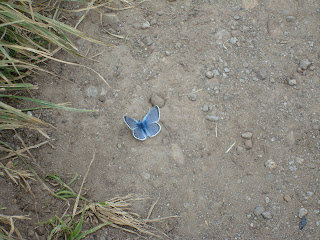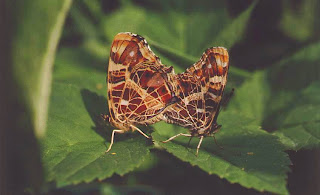This post is composed from notes I took from reading the book. "A World for Butterflies: their lives, behavior and
future" by Phil Schappert, a Lepidopterist (i.e. butterfly biologist) at University of Texas.
Butterflies food

The "high energy" nectar from flowers, which contains mostly sugar, is the main food of butterflies. The flowers butterflies like to visit have some features: relative deep corollas that suits the uncoiled proboscis, produce nectar that contains 20 ~ 25% of sugar, and are often flattened to present a horizontal or vertical "landing pad".
A fact is that plant tissues have almost none of the salt that all animals need for survival. Plant tissues are usually short of nitrogen as well. The butterflies eat a lot alternate foods due to their need for nitrogen, salts, amino acids. These alternates include - tree sap, wet soil, flower pollen, and rotting fruit or vegetables, carrion, dung, urine, bird droppings and sweat. Interestingly male and female butterflies got their nitrogen ad salts differently. I will make a note on this later.
Predators and Defense
In butterflies life cycles, they encounter various predators. These include mammal, spiders, birds, grasshoppers, lizards, dragonfly, amphibians .... even some carnivore plants.
Many butterflies learn via evolution, to avoid spiders and certain plants/flowers. They also learn to protect themselves from hunting predators through camouflage, false head, misleading patterns, chemicals.

False heads and misleading patterns that butterflies develop through evolution, really present the world many marvelous or exotic looking butterflies. Lepidopterists actually captured many evidences that false heads and misleading patterns helped butterflies survival from attacks - e.g. a butterfly with false head survived an attack because it was bitten at the false head which is located near its annal section. An example of misleading pattern is the eye spot that presents in a owl butterfly - which was featured in a picture in the previous post on butterflies. Some butterflies developed chemical defense for themselves! The famous monarch butterfly gains it chemical defense via gaining unleasant checmicals cardenolide aglycones from its host plants - milkweed. Monarchs gained the chemical during its carterpillar stage -caterpillars ingest the chemical as they feed on milkweed. The chemicals make monarch butterflies foul-tasting and poisonous, and birds that try to eat monarch butterflies throw up - emetic response.
Diapause and migration
Diapause - a period of hormonally controlled quiescence, especially in immature insects, characterized by cessation of growth and reduction of metabolic activity, often occurring seasonally or when environmental conditions are unfavorable. Diapause in butterflies is an automatic response to external conditions.It includes slowing of life process, interruption of development, growth or metamorphosis. Monarch butterflies are well known for their thousand-mile migrations. Typical monarch butterflies in the nonmigratory generations have life span of a month or so. The migratory monarch butterflies can live up to 6 ~ 8 months. "The monarchs of eastern north America conduct the longest, best well known migration of any butterflies. Those that eclose in the early Autumn enter reproductive diapause, that is they emerge without fully developed reproductive organs, and may make an astounding southward migration of up to 2500 miles over a period of up to 3 months". The reproductive diapause in the migratory generation leads to their much longer life than non-migratory generation
Note:the black and white butterfly in the picture is neotropic mosaic, a butterfly dissused in the book as an example of the butterfly that survived an attack. The picture was downloaded from
http://texasdiscoverygardens.org/
(to be continued --Butterfly courtship and copulation)



